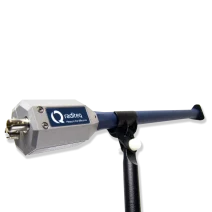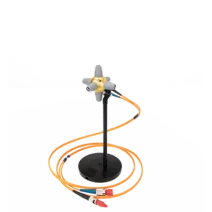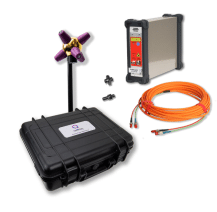Electromagnetic Compatibility (EMC) /
RF Field Probes
RF field probes are specialized measurement devices designed to detect and quantify the electromagnetic fields (EMF) generated by radio frequency (RF) sources. They are commonly used in a wide range of applications, including electromagnetic compatibility (EMC) testing, antenna design, and electromagnetic radiation monitoring.
RF field probes work by detecting the electric and magnetic fields in the vicinity of the RF source. The probe typically consists of a small antenna or coil, which is placed near the source of interest. The probe then measures the electric or magnetic field strength at that point, and the resulting data is recorded or displayed on a measuring device.
RF field probes come in different shapes and sizes, with different frequency ranges and sensitivities, depending on the specific application. Some probes are designed to measure very high-frequency fields, while others are intended for lower-frequency applications. In addition, some probes are highly directional, while others are omnidirectional.
One of the primary uses of RF field probes is in EMC testing, which is used to determine the degree to which a device or system can operate without interfering with other electronic equipment. RF field probes are used to measure the strength of the electromagnetic fields generated by the device being tested, as well as the fields generated by other nearby devices.
RF field probes are also used in antenna design, to measure the strength and directionality of the fields radiated by an antenna. This data is used to optimize the antenna design and ensure that it is radiating the desired signal in the intended direction.
RF field probes are specialized measurement devices designed to detect and quantify the electromagnetic fields (EMF) generated by radio frequency (RF) sources. They are commonly used in a wide range…
...of applications, including electromagnetic compatibility (EMC) testing, antenna design, and electromagnetic radiation monitoring.
RF field probes work by detecting the electric and magnetic fields in the vicinity of the RF source. The probe typically consists of a small antenna or coil, which is placed near the source of interest. The probe then measures the electric or magnetic field strength at that point, and the resulting data is recorded or displayed on a measuring device.
RF field probes come in different shapes and sizes, with different frequency ranges and sensitivities, depending on the specific application. Some probes are designed to measure very high-frequency fields, while others are intended for lower-frequency applications. In addition, some probes are highly directional, while others are omnidirectional.
One of the primary uses of RF field probes is in EMC testing, which is used to determine the degree to which a device or system can operate without interfering with other electronic equipment. RF field probes are used to measure the strength of the electromagnetic fields generated by the device being tested, as well as the fields generated by other nearby devices.
RF field probes are also used in antenna design, to measure the strength and directionality of the fields radiated by an antenna. This data is used to optimize the antenna design and ensure that it is radiating the desired signal in the intended direction.
-
RadiSense® 10 MHz – 26 GHz E-field probe RadiSense® RSS2026H RadiSense® 10 MHz – 26 GHz LASER powered field strength sensor Specifications...FIND OUT MORE
-
RadiSense® 26S | 10 MHz – 26 GHz E-field probe RadiSense® RSS2026S RadiSense® 10 MHz – 26 GHz LASER powered E-field probe Specifications...FIND OUT MORE
-
RadiSense® 40H | 10 MHz – 40 GHz E-field probe RadiSense® RSS2040H RadiSense® 10 MHz – 40 GHz LASER powered field strength sensor...FIND OUT MORE
-
RadiSense® 40S | 10 MHz – 40 GHz E-field probe RadiSense® RSS2040S – This probe specializes in achieving the highest accuracy. Specifications...FIND OUT MORE
-
RadiSense® 20 MHz – 10 GHz laser powered E-field probe RadiSense® RSS2010S RadiSense® 20 MHz – 10 GHz miniature spherical six antenna elements...FIND OUT MORE
-
RadiSense® 20 MHz – 10 GHz laser powered E-field probe RadiSense® RSS2010H RadiSense® 20 MHz – 10 GHz miniature spherical six antenna elements...FIND OUT MORE
-
RadiSense 9 kHz – 10 GHz laser powered E-field probe RadiSense® RSS2010I RadiSense® 10 MHz – 10 GHz miniature spherical six antenna element...FIND OUT MORE
-
RadiSense® 9 kHz – 10 GHz laser powered E-field probe RadiSense® RSS2010B RadiSense® 20 MHz – 10 GHz miniature spherical six antenna elements...FIND OUT MORE
-
RadiSense 10E LASER powered E-field probe set Specifications Frequency range: 20 MHz to 10 GHz Measuring range: 0.5 V/m to 200 V/m Frequency...FIND OUT MORE




